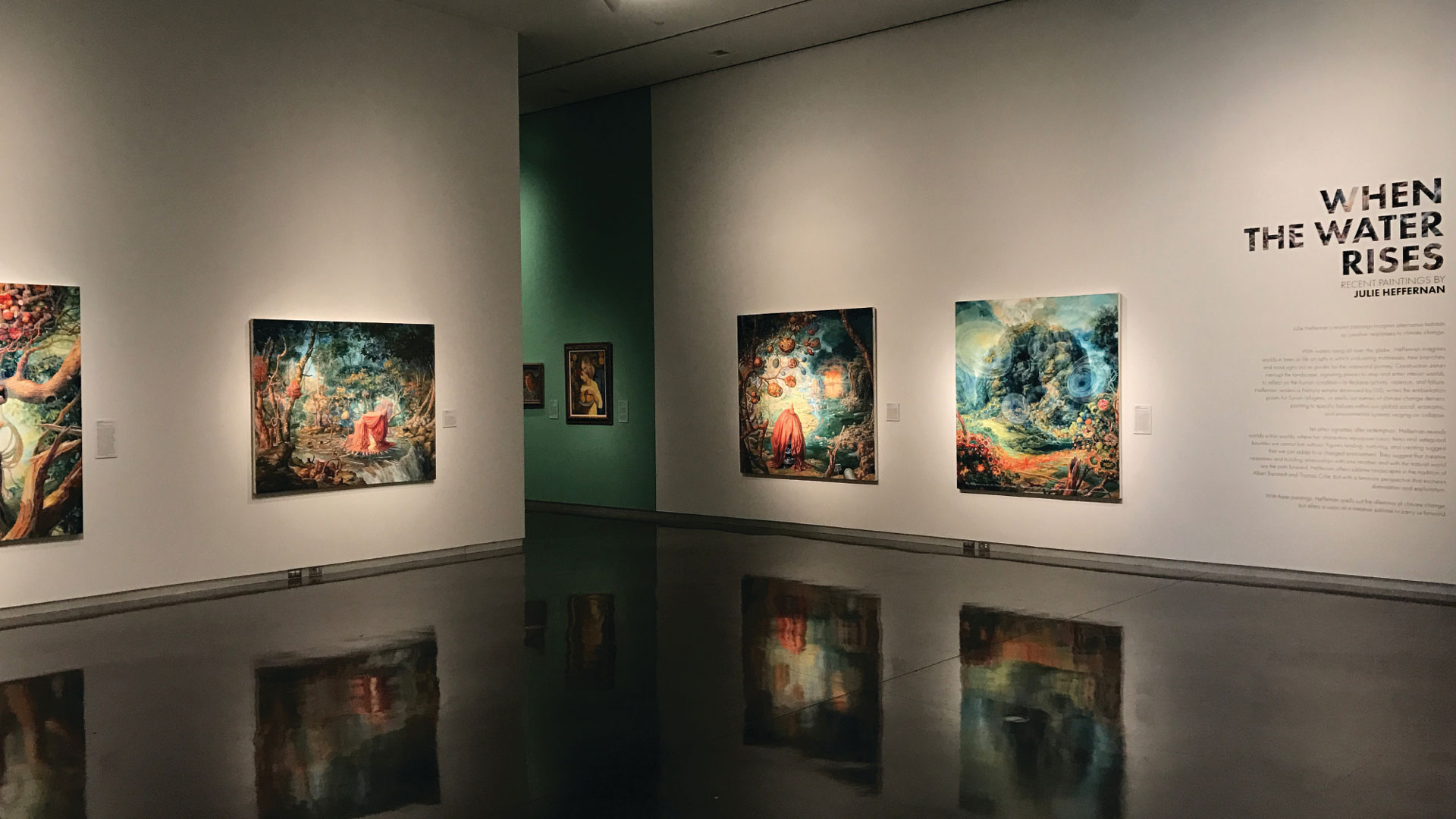Artist makes strong statement on climate change at upcoming exhibition in UHCL's Art
Gallery
December 24, 2018 | UHCL Staff

Instead of showing frightening statistics, protest signs and scientific arguments,
artist Julie Heffernan’s exhibition, “When the Water Rises,” uses color and detailed
imagery to support an introspective, passionate discussion for the message she wants
to spread: climate change is real. The traveling exhibition, originated by the Louisiana
State University Museum of Art, will open at University of Houston-Clear Lake Thursday,
Jan. 24 and run through Thursday, March 21, with an opening preview reception on Jan.
23, 5-7 p.m.
“No matter where this exhibition goes, it’s on point,” said LSU Museum of Art Curator
Courtney Taylor. “Julie’s paintings have several narratives in one larger narrative
painting. She’s a representational storyteller, with portraits, still-life images
and landscapes all rolled into one message and one history lesson.”
“My work is the result of an accumulation of things I’ve studied and researched—the
greenhouse effect, Hurricane Katrina, Hurricane Sandy, and how to talk to family members
who think the idea of climate change is hogwash,” Heffernan said. “I read 'Climate
of Man; Parts I, II and III,' by Elizabeth Kolbert in The New Yorker, which explained
the scientific details of climate change way back in 2005 so that a lay person could
understand. And then Katrina happened, and I saw people’s lives impacted, and my work
changed.”
Heffernan said she wanted to create a powerful body of work and tour it, to get a
conversation going on the topic of climate change. “I couldn’t get it going in my
own family,” she said. “So I hoped to give visual form to something that people couldn’t
imagine on their own. That’s the difference between a painting and a movie. In a movie,
you’re caught up in the drama, but a painting is slower and can put you in a more
contemplative state of mind to be able to process difficult information.”
It’s her objective, she said, to hold a viewer’s eye as long as possible. “Movies
sweep up our imagination, and I want a painting to be a similarly immersive experience.
I don’t what to shortchange the small moments, so there’s a lot of importance put
on little details as well as the overarching meaning of a painting,” she said. “I’m
hoping to engage a viewer from both across the room and also with your nose up close
to the surface.”
Of the 11 pieces in the exhibition, both Heffernan and Taylor think the painting entitled,
“Camp Bedlam” is the focal painting. “It’s an intricate piece,” Taylor said. “This
is what Baton Rouge resembled after the 2016 flood: soggy mattresses, blown-out appliances
and waterlogged furniture lined the streets. But there are small narratives within
the larger narrative.”
“That painting started out half the size that it is now,” Heffernan said. “But the
story just kept getting bigger and more complex. I love epic painting, so just went
for it with this painting. The pile of stuff got twice as big, and I poked little
holes in it to make space for little rooms, like a shanty town. Then I populated it
with characters to show how we might all live in the kinds of habitats that might
spring up after a superstorm, like refugee camps do around the world after there’s
been a disaster.”
Heffernan said “Camp Bedlam” took about six months to create. “I’m not the kind of
painter who works it all out beforehand,” she said. “I have a vague idea before I
start, and then I ask myself questions all along the way to allow the painting to
get more depth and complexity.”
Taylor said that Heffernan’s work explores the way people come together organically
after a disaster and consider what things are actually necessary to get through. “We
keep accumulating stuff, but what we need is each other, along with empathy and patience,”
Taylor said. “Her work shows that the problems are messy and unresolved. There are
good and bad forces, and well-intentioned forces that turn bad.”
Heffernan’s work demonstrates that people have become adept at cleaning up after disasters,
allowing them then to soon forget the event ever happened. The space between one extreme
weather event and the next is shrinking, and people find themselves constantly on
the brink.
“My hope is that even if people do something small, like stop using plastic, we can
create enough of a critical mass to demand of our politicians big changes in policy
around climate change, like a carbon tax, just to start,” Heffernan said. “It’s not
just about recycling and conserving. It’s much bigger. Most of us who are sensitive
to the issue are trying to do our best, but until everyone is on board, you feel that
your own attempt is just a needle in a haystack.”
For more information about UH-Clear Lake's Art Gallery exhibitions, visit www.uhcl.edu/art-gallery/
About the Author:
Recent entries by
October 18 2022
Better technology transforms campus safety: Police Chief demonstrates SafeZone to students
October 14 2022
Student's skill with drones takes chicken turtle research to new heights
October 11 2022
Planting event to help UHCL restore native plants to campus, support environmental sustainability







